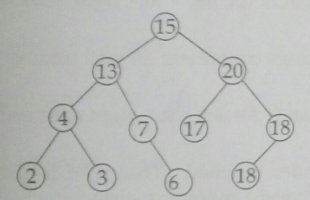31. A data cube C, has n dimensions, and each dimension has exactly p distinct values in the base cuboid. Assume that there are no concept hierarchies associated with the dimensions. What is the maximum number of cells possible in the data cube, C?
(A) pn (B) p
(C) (2n-1)p+1 (D) (p+1)n
Answer: D
Explanation:
(a) What is the maximum number of cells possible in the base cuboid?
pn.
This is the maximum number of distinct tuples that you can form with p distinct values per dimensions.
(b) What is the minimum number of cells possible in the base cuboid?
p.
You need at least p tuples to contain p distinct values per dimension. In this case no tuple shares any value on any dimension.
(c) What is the minimum number of cells possible in the data cube, C?
(2n-1)×p+1.
The minimum number of cells is when each cuboid contains only p cells, except for the apex, which contains a single cell.
(d) What is the maximum number of cells possible (including both base cells and aggregate cells) in the data cube, C?
(p+1)n.
The argument is similar to that of part (a), but now we have p+1 because in addition to the p distinct values of each dimension we can also choose ∗.
- Suppose that from given statistics, it is known that meningitis causes stiff neck 50% of the time, that the proportion of persons having meningitis is 1/50000, and that the proportion of people having stiff neck is 1/20. Then the percentage of people who had meningitis and complain about stiff neck is:
(A) 0.01% (B) 0.02%
(C) 0.04% (D) 0.05%
Answer: B
Explanation:
The computation is based on the simplified Bayes’ formula.
P{B|A} = (P{A|B}•P{B) / P{A}.
P{M|S} = probability that a person had meningitis, conditioned by the existence of stiff neck.
P{S|M} = probability that a person complains about stiff neck, conditioned by the existence of meningitis. = 50%=1/2
P{S} = proportion of people who complain about stiff neck. = 1/20
P{M} = proportion of people who had meningitis. = 1/50,000
Then:
P{M|S} = (P{S|M}•P{M}) / P{S} =(1/2 x 1/50,000) / 1/20 = 0.0002 = 0.02%
- …………….. system is market oriented and is used for data analysis by knowledge workers including Managers, Executives and Analysts.
(A) OLTP (B) OLAP
(C) Data System (D) Market System
Answer: B
Explanation:
– OLTP (On-line Transaction Processing) is characterized by a large number of short on-line transactions (INSERT, UPDATE, DELETE). The main emphasis for OLTP systems is put on very fast query processing, maintaining data integrity in multi-access environments and an effectiveness measured by number of transactions per second. In OLTP database there is detailed and current data, and schema used to store transactional databases is the entity model (usually 3NF). – OLAP (On-line Analytical Processing) is characterized by relatively low volume of transactions. Queries are often very complex and involve aggregations. For OLAP systems a response time is an effectiveness measure. OLAP applications are widely used by Data Mining techniques. In OLAP database there is aggregated, historical data, stored in multi-dimensional schemas (usually star schema).
ref: http://datawarehouse4u.info/OLTP-vs-OLAP.html
- ……………… allows selection of the relevant information necessary for the data warehouse.
(A) The Top-Down View (B) Data Warehouse View
(C) Data source View (D) Business Query View
Answer: A
- The hash function used in double hashing is of the form:
(A) h(k, i)=(h1(k)+h2(k)+i)mod m (B) h(k, i)=(h1(k)+h2(k)-i)mod m
(C) h(k, i)=(h1(k)+ih2(k))mod m (D) h(k, i)=(h1(k)-ih2(k))mod m
Answer: C
Explanation:
|
Double hashing uses the idea of applying a second hash function to the key when a collision occurs. The result of the second hash function will be the number of positions form the point of collision to insert. There are a couple of requirements for the second function: it must never evaluate to 0 must make sure that all cells can be probed
|
- In the following graph, discovery time stamps and finishing time stamps of Depth First Search (DFS) are shown as x/y where x is discovery time stamp and y is finishing time stamp.

It shows which of the following depth first forest?
(A) {a,b,e} {c,d,f,g,h} (B) {a,b,e} {c,d,h} {f,g}
(C) {a,b,e} {f,g} {c,d} {h} (D) {a,b,c,d} {e,f,g} {h}
Answer: C
Explanation:
Check for the Cycles in the graph, you will find that node A,B,E form one cycle. node F,G form another cycle. Node C,D form another cycle. and H is having self loop.
- The number of disk pages access in B-tree search, where h is height, n is the number of keys, and t is the minimum degree, is:
(A) θ(logn h*t) (B) θ(logt n*h)
(C) θ(logh n) (D) θ(logt n)
Answer: D
- The inorder traversal of the following tree is:

(A) 2 3 4 6 7 13 15 17 18 18 20
(B) 20 18 18 17 15 13 7 6 4 3 2
(C) 15 13 20 4 7 17 18 2 3 6 18
(D) 2 4 3 13 7 6 15 17 20 18 18
Answer: D
Explanation:
|
Use In-order Traversal i.e Left–Root–Right. following this we have first root at 15, then left sub tree root at 13, then left subtree root at 4, then left is 2 and so on which results in 2 4 3 13 7 6 15 17 20 18 18
|
- An ideal sort is an in-place-sort whose additional space requirement is ……………
(A) O(log2n) (B) O(nlog2n)
(C) O(1) (D) O(n)
Answer: C
- Which of the following is not a congestion policy at network layer?
(A) Flow Control Policy
(B) Packet Discard Policy
(C) Packet Lifetime Management Policy
(D) Routing Algorithm
Answer: A
